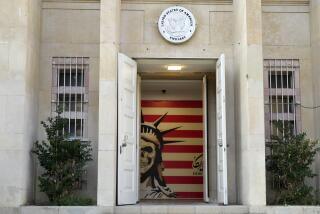AROUND HOME : Staffordshire Figures
- Share via
MANY A MANTEL in the Western world boasts a pair of Staffordshire figures, earthenware characters made in the pottery towns of central England during the Industrial Revolution. The subjects were generally made in pairs and often plain-backed, for viewing from one side only. Chief colors were orange and underglaze blue.
Most familiar today were those figures made between 1837, when Victoria came to the throne, and the end of that century. The average Victorian tended to be patriotic, sentimental and a great lover of animals. And more than simply providing him with decoration, Staffordshire figures kept him abreast of current affairs. Today these figures form a unique chronicle of the age of Victoria, setting down royal marriages and births, glorious military, political and scientific victories--and defeats--and heroes and heroines to make every Englishman proud.
The largest single group of Staffordshire figures was made up of the royal family. Queen Victoria and Prince Albert had four sons and five daughters, most of whom were modeled at least twice. In addition, there were innumerable soldiers and sailors, as the century had more than its share of conflicts: the Crimean War, the Indian Mutiny, the Franco-Prussian War, the Egyptian and Sudan Campaigns and the Boer War among them.
Many murderers and their victims were modeled. Dr. Palmer, the wife poisoner, was a favorite. There were also boxers, cricket players and jockeys of the day, along with politicians such as Sir Robert Peel and Benjamin Disraeli, and heroes and heroines including Garibaldi and Florence Nightingale. There were authors--Shakespeare, Milton, Chaucer, Byron and Sir Walter Scott, among many others. Jumbo the Elephant, brought to England by P. T. Barnum, was wildly popular, as were lions and horses and, of course, dogs--with aristocrats such as the racing greyhounds Master M’Grath and Pretender leading the pack.
Staffordshire is folk art at its most appealing, a vivid record of Victorian history. So many figures were produced during the 19th Century that there are myriad available now.
Staffordshire figures have been carried at the Antique Mart and Century Past in Los Angeles; Speidel Antiques in Pacific Palisades; Jay’s Antiques, Pasadena Antique Center and Estate Sales Unlimited, all in Pasadena; Allison’s Relics in Riverside; Country Living in Newport Beach; Antique Emporium in Costa Mesa; Best of Times Antique Center in San Pedro; McDonald’s Antiques and House of Heirlooms, both in San Diego.
More to Read
Sign up for Essential California
The most important California stories and recommendations in your inbox every morning.
You may occasionally receive promotional content from the Los Angeles Times.












